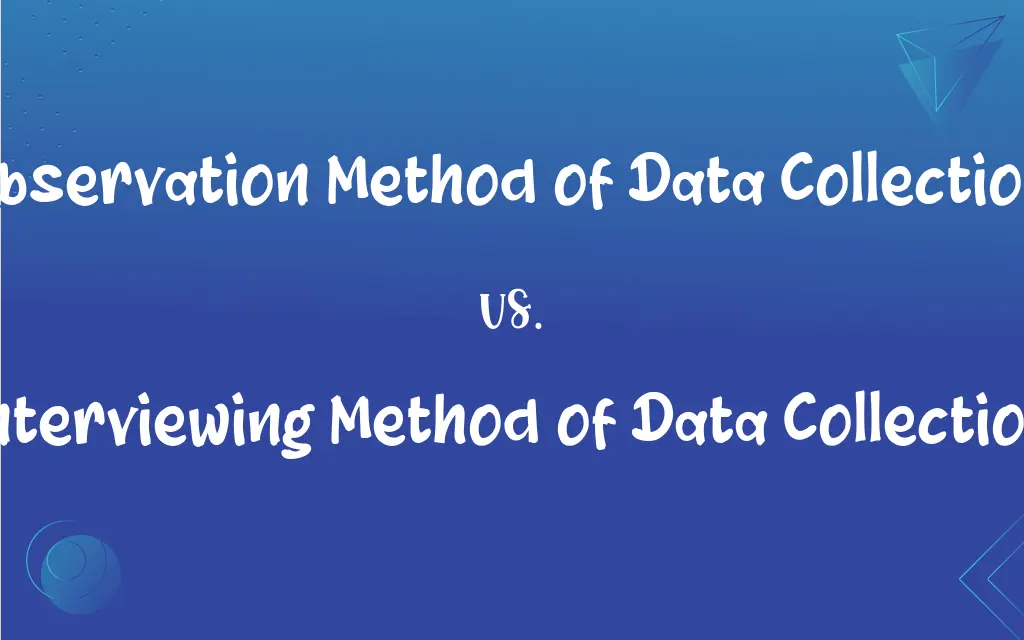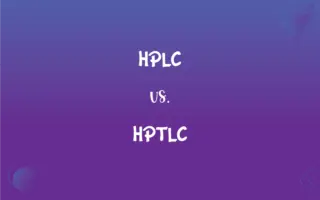Observation Method of Data Collection vs. Interviewing Method of Data Collection: What's the Difference?
Edited by Aimie Carlson || By Harlon Moss || Published on March 11, 2024
The observation method involves collecting data by watching subjects, while the interviewing method involves collecting data by asking subjects questions directly.

Key Differences
The observation method of data collection involves watching and recording behaviors or phenomena as they occur naturally, ensuring data is collected without direct interaction. Conversely, the interviewing method involves direct interaction, where researchers collect data by asking participants questions, gaining insights into their thoughts, feelings, and experiences.
In the observation method, researchers remain passive observers, minimizing their influence on the subject's natural behavior. In contrast, interviewing requires the researcher to actively engage with participants, guiding the conversation through questions to extract the desired information.
Observation methods typically yield quantitative data, capturing the frequency or duration of certain behaviors, although qualitative observations are also possible. Interviewing methods, however, predominantly provide qualitative data, offering deep insights into participants' attitudes, motivations, and personal perspectives.
The observation method allows researchers to understand the context or environment in which behaviors occur, often providing a holistic view of the situation. Interviewing methods, while offering depth, may miss out on contextual factors, relying on the participant's ability to accurately recall and articulate their experiences.
The observation method is particularly suited for studies where behavior is best understood in its natural setting, but it may miss subjective insights into why behaviors occur. Interviewing allows for exploring these subjective elements but may be limited by participants' memory biases or willingness to share.
ADVERTISEMENT
Comparison Chart
Interaction Level
Non-interactive, passive.
Interactive, direct.
Data Type
Quantitative (behavior frequency) and qualitative (contextual notes).
Qualitative (thoughts, feelings, opinions).
Influence on Subjects
Minimal, aiming for natural behavior.
Potentially significant, guided by questions.
Contextual Understanding
High, observes behavior in natural setting.
Lower, relies on participant's perspective.
Suitability
Best for observing natural behaviors.
Best for understanding thoughts and motives.
ADVERTISEMENT
Observation Method of Data Collection and Interviewing Method of Data Collection Definitions
Observation Method of Data Collection
Provides a visual record of events, behaviors, or conditions as they naturally occur.
Using the observation method, the team documented the daily routines of the nocturnal animals.
Interviewing Method of Data Collection
Dependent on participants' willingness to share and their ability to recall and articulate.
The interviewing method revealed valuable insights, although some participants were hesitant to discuss sensitive topics.
Observation Method of Data Collection
Involves watching subjects without altering their natural environment or behavior.
The observation method was crucial in understanding the unaltered social interactions in the community.
Interviewing Method of Data Collection
A direct, interactive method where researchers ask participants questions to gather data.
The interviewing method provided deep insights into the patients' experiences with the new treatment.
Observation Method of Data Collection
A non-interactive method capturing behaviors or phenomena in their natural setting.
The researcher used the observation method to study the feeding patterns of birds in the wild.
Interviewing Method of Data Collection
Enables gathering in-depth, subjective data directly from the source.
The interviewing method was key in understanding the personal impact of the disaster on the survivors.
Observation Method of Data Collection
Offers contextual insights by capturing the environment and circumstances surrounding behaviors.
The observation method revealed how environmental changes influenced the behavior of the species.
Interviewing Method of Data Collection
Involves verbal communication, allowing researchers to explore participants' thoughts and feelings.
Through the interviewing method, the researcher uncovered the community's perception of the new policy.
Observation Method of Data Collection
Minimizes researcher's influence, aiming for objective and unbiased data collection.
The observation method ensured that the data on children's play behavior was collected without any intervention.
Interviewing Method of Data Collection
Can be structured, semi-structured, or unstructured, offering flexibility in data collection.
The semi-structured interviewing method allowed the interviewer to explore unexpected topics that emerged.
FAQs
How do researchers remain unbiased using the observation method?
By minimizing interaction and maintaining a passive role during data collection.
How does the interviewing method ensure data accuracy?
By directly engaging with participants and clarifying responses in real-time.
Is the interviewing method suitable for all types of research?
It's best suited for studies requiring in-depth understanding of personal experiences or opinions.
What challenges are faced in the interviewing method?
Challenges include potential bias, inaccurate recall, and reluctance to share sensitive information.
What is the main advantage of the observation method?
It allows data collection without interfering with the subject's natural behavior.
What types of questions are used in the interviewing method?
Questions can be open-ended, closed-ended, or a mix, depending on the research goal.
Is training required for the observation method?
Yes, observers need training to accurately record behaviors and minimize personal bias.
Can the observation method capture emotional data?
It's limited in this aspect, often requiring complementary methods for emotional insights.
How time-consuming is the observation method?
It can be time-consuming, especially in natural settings where behaviors occur unpredictably.
Does the observation method guarantee privacy for subjects?
It respects privacy, but ethical considerations and consent are crucial, especially in sensitive settings.
Can technology be used in the interviewing method to improve data collection?
Yes, digital recording devices and software can enhance data accuracy and analysis.
How do observers avoid influencing behavior in the observation method?
By blending into the background and avoiding any direct interaction with subjects.
What role does body language play in the interviewing method?
It provides additional context and can indicate comfort levels, enhancing the understanding of verbal responses.
Can the observation method be used in controlled environments?
Yes, it can be used both in natural settings and controlled environments, like laboratories.
How does the interviewing method handle misinterpretation of questions?
By clarifying questions and ensuring the participant fully understands before responding.
What ethical considerations are involved in the observation method?
Ensuring subjects' privacy, obtaining consent, and minimizing the impact on their natural behavior.
How is confidentiality maintained in the interviewing method?
By anonymizing data and ensuring secure storage and handling of sensitive information.
How do researchers handle unresponsive participants in interviews?
By using probing questions or rephrasing to encourage engagement and elaboration.
Can the interviewing method be used for quantitative data?
It's primarily qualitative, but structured interviews can also collect quantitative data.
How does the observation method handle large groups of subjects?
It can be challenging but structured observation guides and multiple observers can improve data collection.
About Author
Written by
Harlon MossHarlon is a seasoned quality moderator and accomplished content writer for Difference Wiki. An alumnus of the prestigious University of California, he earned his degree in Computer Science. Leveraging his academic background, Harlon brings a meticulous and informed perspective to his work, ensuring content accuracy and excellence.
Edited by
Aimie CarlsonAimie Carlson, holding a master's degree in English literature, is a fervent English language enthusiast. She lends her writing talents to Difference Wiki, a prominent website that specializes in comparisons, offering readers insightful analyses that both captivate and inform.































































